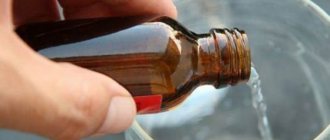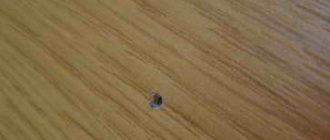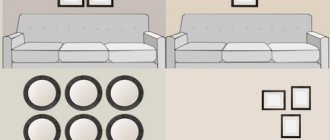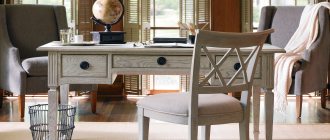The condition of the furniture deteriorates over time. Regardless of operating conditions, the finishing coating loses its strength, becomes covered with a network of small cracks, and becomes dull or cloudy.
Scratches and abrasions appear, which spoil the appearance of the furniture and make it unsuitable for use in the interior of residential or public premises. However, in most cases the condition of the surfaces can be restored, and sometimes it is possible to make the furniture more attractive than it was before.
What is polishing
Polishing is a process of finely treating a surface, giving it shine. As a rule, the varnish layer is polished, but the procedure can also be performed on the paint or the material itself. The processing technique is close to grinding, but the fineness of the abrasive in this case is an order of magnitude higher.
There are different degrees of surface gloss. There are glossy finishes that are highly shiny and reflective to surrounding objects. Furniture finished in this way looks elegant, bright, and glares when exposed to light.
Matte surfaces do not reflect light, their shine is very soft. As a rule, matte types of varnish are used for modern furniture, but ancient samples were coated with a special composition (classic shellac), or the wood was simply impregnated with oil, followed by processing with cloth swabs.
Expert opinion
Kokovin Dmitry Vasilievich
Furniture restorer
There are different polishing techniques. The basic method is to apply a special polishing paste to the prepared surface and process it using a polishing wheel made of foam rubber, felt, felt and other materials.
What materials can be polished?
As a rule, furniture coating is a varnish layer of one composition or another. In Soviet times, the main type of coating was polyester varnish. It was applied in a thick layer (0.5-0.8 mm), ground and polished on special production lines.
Modern furniture has a varnish coating made on the basis of the same polyester. Or other materials. there are many of them, but the general properties are approximately the same.
The most common coatings are:
- polyester;
- polyurethane;
- nitrocellulose;
- impregnation with oil of natural or synthetic origin.
Almost all varieties can be polished. The softer the varnish, the easier it is to polish, but its abrasion resistance is much lower.
Paints and varnishes that are sold in retail chains are of little use for creating high-quality furniture coatings. They do not meet standards for hardness and load resistance. For restoring furniture coverings, they are suitable only in certain cases and require proper use.
Industrial polishes - are they worth buying?
Industrial polishes contain special substances that fill microcracks in the furniture surface, as a result of which the structure of the material becomes even and smooth - polished.
Today, store shelves are filled with a variety of products from different manufacturers. They, to one degree or another, make care easier, but how safe and effective they are is always up to the consumer to evaluate after purchase. This is a matter of personal choice.
You can find furniture wax on the shelves of hardware stores. This substance has been used to coat furniture for centuries. And today it ranks first in wood processing and care.
What are the advantages of using wax:
- furniture can withstand long-term loads;
- wood does not lose its texture, retaining natural warmth;
- the velvety properties of the material are preserved;
- after coating, the color of the product becomes more expressive;
- the ability to choose any tone during restoration;
- The thick consistency fits well on the surface of the wood, filling all cracks and scratches.
- furniture wax should be applied to clean, open-pore furniture (so that there are no paint coatings);
- a labor-intensive process when the surface is varnished (needs to be thoroughly cleaned).
This is the option when you can trust the manufacturer, because more than one housewife has already noted the effectiveness of this brand’s products for various purposes.
An excellent Amway polish, which has established itself as an ideal assistant for the care of wooden and lacquered furniture.
- creamy structure - does not flow, does not drip;
- fresh lemon aroma - non-toxic;
- convenient aerosol can;
- easy to use.
Methods for polishing furniture at home
Despite its apparent complexity, polishing is not a high-tech process and is quite accessible to do it yourself. Its only drawback is that it is labor intensive; the work requires care, time and effort.
Felt
Felt
The main method of polishing a new coating is to apply a polishing compound and treat the surface with felt or felt material. To obtain a mirror shine, you have to use special devices - attachments for an electric drill or grinding machines, otherwise the procedure will take too long.
Polishing technology has been known to people for a very long time. It has been improved, supplemented, and improved over thousands of years. Today, at home, you can use different techniques, which are chosen depending on the initial condition and type of coating.
Classic polishing
Ancient polishing methods differ markedly from modern ones. In practice, this is a separate technology that is rarely used today. Simultaneous application and polishing of a varnish composition or polish is carried out. This is shellac tree resin dissolved in ethyl alcohol.
The polishing process is carried out using a swab. Take a piece of clean linen cloth the size of a handkerchief. A lump of cotton wool the size of a large plum is placed inside. A little polish is poured into it, wrapped in a cloth and the surface begins to be processed in a circular motion.
The composition impregnates the tampon and fabric and is applied in small quantities to the surface. It dries immediately on it, so you need to act quickly, without stopping. If the swab is stopped in one place, the polish will dissolve the already created layer and ruin the entire work.
Expert opinion
Kokovin Dmitry Vasilievich
Furniture restorer
Classic polishing is a complex procedure that requires experience and skill. In addition, it is very difficult to get natural shellac today, so this technique is rarely used. Basically, it is used by master restorers to restore antique furniture.
Traditional methods
Folk polishing methods are quite simple, but quite effective. As a rule, they involve treating the surface with soft materials using a fine abrasive, for example:
Dentifrice
Toothpaste
Chalk
Talc
To reduce heat due to friction, oil (sunflower, linseed or synthetic) is used. It is applied to the surface or to a polishing block, which eliminates the risk of overheating and damage to the varnish layer. To simplify the process, make a mixture of abrasive (chalk, tooth powder) and oil filler (linseed, sunflower oil).
For fittings, metal parts or hard components, only abrasive can be used, without filler. It is poured onto a felt or felt block and the surface is rubbed until shiny.
Polishing pastes or compounds
In furniture production, special compounds are used to polish the surface to a mirror finish. They are rarely found on the open market, as they are supplied in large packages. It is not advisable to purchase them for household use.
However, there are effective and high-quality pastes for polishing car coatings. They are sold in small containers (1 kg, 800 g, etc.), and to treat a small area you can buy a very small amount of material.
One such composition is 3M paste, which is available in several forms:
- No. 1. Used for rough (primary) processing of surfaces after grinding. Removes small marks and abrasive marks;
- No. 2. Brings the surface to a mirror state;
- No. 3. Brings the coating to its final state and gives the surface a durable protective layer.
In addition to the basic compositions, there are intermediate ones - numbers 1.5 and 2.5. These compositions simultaneously possess the properties of lower and higher materials.
There are other polishing compounds on the market. There are hard pastes (such as GOI) that are used for polishing hard surfaces. However, most materials are made in the form of thick pastes (the consistency of sour cream or toothpaste), which are more convenient to apply and work with. They all have approximately similar qualities and allow you to effectively and quickly bring the surface to ideal condition.
LiveInternetLiveInternet
–Tags
–Categories
- Scrap kits (511)
- Romantic scrap sets (146)
- Children's scrap kits (115)
- Flower scrap kits (83)
- Fairytale scrap kits (66)
- Summer scrap kits (61)
- Vintage scrap kits (55)
- Spring scrap kits (50)
- Winter, Christmas and New Year scrap sets (37)
- Culinary scrap kits (24)
- Autumn scrap kits (23)
- Marine scrap kits (21)
- Scrap kits – handicrafts (12)
- Easter scrap kits (9)
- Wedding scrap sets (8)
- Others (7)
- Glamorous scrap sets (7)
- Calendars (5)
- Gothic scrap sets (4)
- Steampunk scrap kits (1)
- Everything for a diary (118)
- Design of a diary and “decoration” (67)
- flash (34)
- My designs (16)
- For beginners. (14)
- Avatars (8)
- Blog optimization (3)
- To my readers (62)
- Animation (57)
- Handicrafts (45)
- Icons (25)
- Online shopping (19)
- Interior design (18)
- Desktop wallpapers (10)
- Economics, politics, just thinking out loud.. (4)
- DIY (3)
- Frames (1)
- Html (for post design) (1)
- Home Economics (21)
- Women's tricks (7)
- Painting (181)
- Health (29)
- Interesting (54)
- Clipart (337)
- Collages (12)
- Beauty (141)
- Cooking (997)
- Sweet pastries and dough products (399)
- Master classes (305)
- Salads and snacks (196)
- Savory baked goods and dough products (169)
- Other (123)
- Dishes for children (73)
- Meat dishes (73)
- Dessert and cakes without baking (63)
- Main courses (59)
- Poultry dishes (58)
- Fish dishes (42)
- Casseroles (22)
- Canning and preparations (21)
- Cooking in a slow cooker (13)
- Borscht, okroshka, solyanka (6)
- Rabbit dishes (2)
- Fashion and beauty (27)
- Postcards (47)
- Poetry and prose (89)
- Psychology (6)
- Dividers (17)
- Frames (59)
- PNG (for photo design) (5)
- Drawing with children (1)
- Photography as art (90)
- Photoshop (87)
- Masks (12)
- Photoshop lessons (41)
- I'm a mom (66)
- Speech therapist classes (7)
Useful tips
Polishing is a largely creative process. However, it is better to act according to proven methods and not violate technology.
How do you polish?
ClassicFolk
It is recommended to follow some tips:
- During operation, do not apply too much force or put pressure on the machine. This may cause the coating to overheat;
- If marks or scratches are clearly visible, you should not start polishing. It is necessary to carefully prepare the surface. sometimes this is neglected, hoping that the flaws will disappear during processing. However, they will remain and will be clearly visible;
- Matte finishes do not polish. Sometimes they become covered with shiny areas, which are restored using scratch paper.
By following these simple tips, you can get high-quality coverage and avoid annoying mistakes.
Furniture polishing is a procedure that allows you to restore old products and correct errors made during operation or transportation. The polishing technology is simple, but high quality can only be achieved with skills and experience. Otherwise, the flaws in the coating will only be exacerbated. If you don’t have confidence in your abilities, it’s better to entrust the work to specialists.










